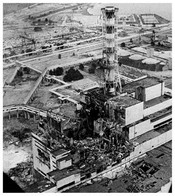Seminar: Chernobyl: 30 Years Later
Chernobyl: 30 Years Later

Seminar Speaker: Dr. James E. Alleman – Notre Dame Alumnus
Joel and Judy Cerwick Professor of Environmental Engineering,
Department of Civil, Construction and Environmental Engineering,
Iowa State University Jefferson Science Fellow
USAID Bureau for Europe and Eurasia
Abstract:

Chernobyl’s nuclear power plant disaster in 1986 still represents a haunting nightmare. Whether measured by human and environmental impact, engineering challenge, or overall cost, this accident represents the world’s worst-ever nuclear facility failure, with a radiation release estimated at ten times higher than Fukushima. Set against this frightful legacy, though, the Chernobyl site is in the final stages of installing an extraordinary new shelter structure which will provide secure and safe closure for the next century. Indeed, this ‘new safe confinement’ (NSC) structure is a keystone element of a remarkable shelter implementation plan which will eventually deconstruct and safely dispose of both the failed structure and its residual nuclear debris. This new, arch-shaped structure is an absolute engineering marvel. It is the largest, moving, land-based structure every built, with a vast interior volume large enough to cover both the Statue of Liberty and Washington DC’s National Cathedral. Having been built off-site to reduce radiation-based construction risks, the arch will then be skidded forward on cutting-edge Teflon-coated pads to its final location stretched entirely over Chernobyl’s #4 failed reactor. This special presentation will consequently review Chernobyl’s remarkable past, present, and future circumstance.
Biography:
Dr. James E. Alleman is the Joel and Judy Cerwick Professor of Environmental Engineering with Iowa State University’s Department of Civil, Construction, and Environmental Engineering. Professor Alleman obtained his BS, MS and PhD degrees in Civil and Environmental Engineering at the University of Notre Dame. Joining ISU in 2005 after completing a Fulbright Research-Scholar assignment at the Technical University of Crete in Xania, Greece, he served as a departmental Chair for six years. Dr. Alleman’s additional career appointments sequentially included the U.S. Army Medical Service Corps in Okinawa, Japan (1972-1975), the University of Maryland (1978-1982), Purdue University (1982-2005), and a sabbatical Visiting Professor affiliation with the University of Leeds (1989). While at Purdue, he served as both an Assistant Head for the School of Civil Engineering and as an Associate Director for a $10M NASA-sponsored NSCORT Advanced Life Support research center where he managed projects connected with water, air, and waste management strategies for deep-space missions. Dr. Alleman’s academic and research interests are connected with environmental engineering, with emphasis on sustainable engineering systems in relation to water, wastewater, and transportation infrastructure. His advising and publication metrics include 15 PhD recipients whose research outcomes were then published in 70 refereed journal papers and 30-plus conference proceedings, and he co‐authored a related textbook entitled, "Environmental Biology for Engineers and Scientists.” Dr. Alleman is a registered PE in Indiana, a Fellow member of the American Society of Civil Engineers, and recent Jefferson Science Fellow with the US State Department and USAID.
Please view the flyer for more information.
Sponsored by the Department of Civil & Environmental Engineering & Earth Sciences at the University of Notre Dame.